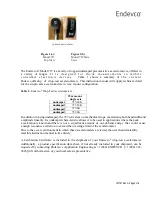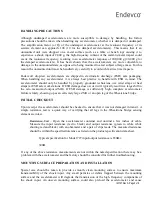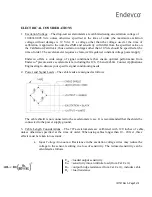
IM727 Rev A, Page 5 of 9
®
ELECTRICAL CONSIDERATIONS
1. Excitation Voltage – The drop-test accelerometers are calibrated using an excitation voltage of
10.000±0.005 Vdc, unless otherwise specified at the time of order (the maximum excitation
voltage without damage is 12 Vdc). If a voltage other than the voltage used at the time of
calibration is applied to the unit, the ZMO and sensitivity will differ from the specified value on
the Calibration Certificate, thus excitation voltages other than 10 Vdc should be specified at the
time of order. The accelerometer requires a clean, well-regulated, constant voltage power supply.
Endevco offers a wide range of signal conditioners that ensure optimal performance from
Endevco
®
piezoresistive accelerometers, including the 126, 136 and 4430A. Contact Applications
Engineering to discuss your specific signal conditioning needs.
2. Power and Signal Leads – The cable leads are assigned as follows:
The cable shield is not connected to the accelerometer case. It is recommended that the shield be
connected to the power supply ground.
3. Cable Length Considerations – The 727 accelerometers are calibrated with 120 inches of cable,
unless otherwise specified at the time of order. When using cables longer than 10 – 20 feet , three
effects must be taken into account:
a.
Input Voltage Attenuation
: Resistance in the excitation voltage wires may reduce the
voltage to the sensor, resulting in a loss of sensitivity. The reduced sensitivity can be
calculated as follows:
E
OL
= loaded output sensitivity
Eo = sensitivity into an infinite load (from Cal. Cert.)
R
O
= output bridge resistance (from Cal. Cert.), includes cable
R
L
= load resistance









